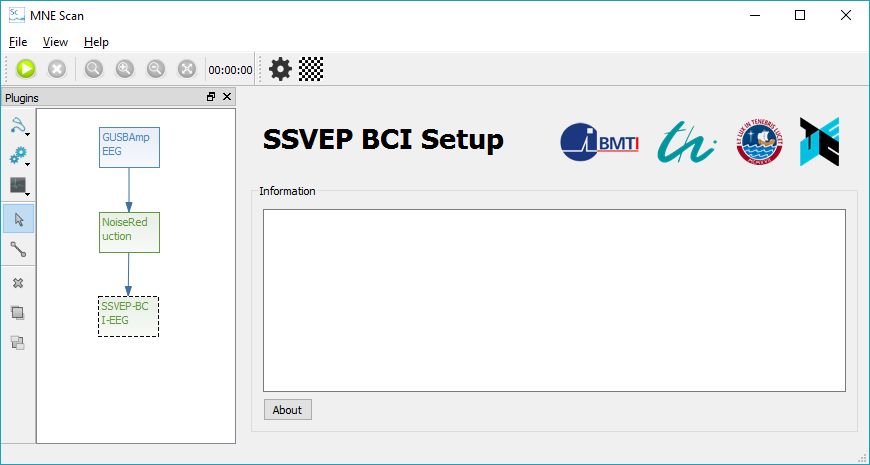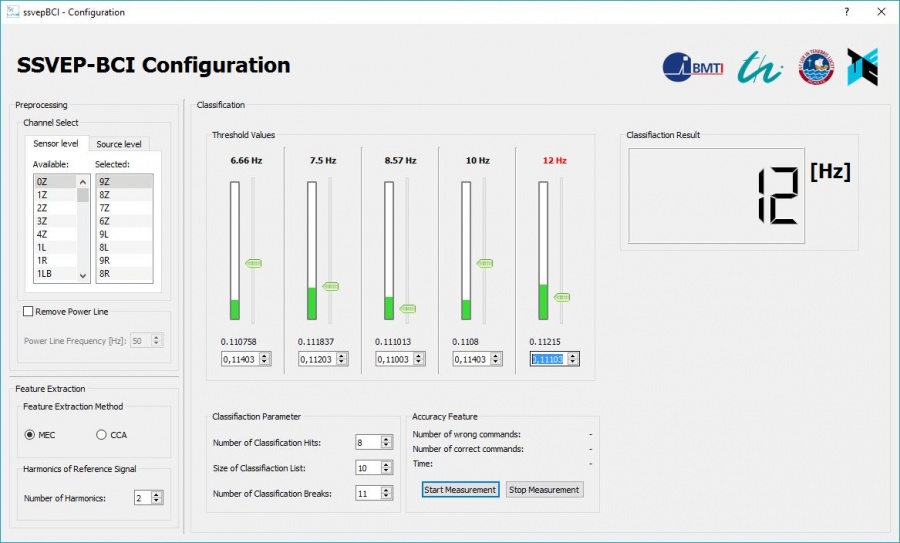Difference between revisions of "Setup SSVEP BCI example"
| Line 4: | Line 4: | ||
== Editing the Processing Pipeline == | == Editing the Processing Pipeline == | ||
| + | |||
| + | |||
In the following figure an edited setup of the SSVEP-BCI processing pipeline is shown in the MNE-Scan GUI environment. For this example the NoiseReduction plugin was interposed as a preprocessing step in order to increase the Signal-to-Noise ratio. However, the SSVEP-BCI plugin can also be processed with "raw" (unfiltered) data by connecting it directly with the acquisition plugin. | In the following figure an edited setup of the SSVEP-BCI processing pipeline is shown in the MNE-Scan GUI environment. For this example the NoiseReduction plugin was interposed as a preprocessing step in order to increase the Signal-to-Noise ratio. However, the SSVEP-BCI plugin can also be processed with "raw" (unfiltered) data by connecting it directly with the acquisition plugin. | ||
| − | [[File:MNE-Scan processing pipelilne.jpeg| | + | [[File:MNE-Scan processing pipelilne.jpeg|frame|center|SSVEP BCI processing pipeline in the MNE-Scan environment]] |
== Adjusting the SSVEP-BCI == | == Adjusting the SSVEP-BCI == | ||
| − | Like already mentioned, in the thesis "[http://opac.lbs-ilmenau.gbv.de/DB=1/SET=2/TTL=1/CMD?ACT=SRCHA&IKT=1016&SRT=YOP&TRM=Development+of+a+BCI+based+on+real-time+neural+source+localization Development of a BCI based on real-time neural source localization]" different scientific approaches are combined in order to realize this BCI. The adjustment of these features can be done by | + | Like already mentioned, in the thesis "[http://opac.lbs-ilmenau.gbv.de/DB=1/SET=2/TTL=1/CMD?ACT=SRCHA&IKT=1016&SRT=YOP&TRM=Development+of+a+BCI+based+on+real-time+neural+source+localization Development of a BCI based on real-time neural source localization]" different scientific approaches are combined in order to realize this BCI. The adjustment of these features can be done by clicking the configuration icon:[[File:Configuration.png|20px|link=]] on the SSVEP-BCI's GUI which is depictured in the previous figure. With this command, the configuration GUI is opened which is shown in the following figure. |
| + | |||
| + | [[File:SSVEPConfigurationWindow.jpg|right|900px|thumb| Configuration Window of the SSVEP-BCI plugin]] | ||
| + | |||
| + | Following adjustment can be done with the configuration GUI: | ||
| + | |||
| + | ===== Channel Select ===== | ||
| + | The channel select is realized with a .txt-file which is located under "''MNE-CPP Folder''-bin-mne_scan_plugins-resources-ssvepBCI", like the already included "Pinning_Scheme_Duke_Dry_64.txt" file. These files behold the mapping of the channel names according to the channel number in the FIFF-file. You can change the current selected folder or link the plugin to a new edited file. | ||
| + | In the latter case, the new edited file-name has to be changed in line 241 of the "ssvepbciconfiguration.cpp" file. Also the default channels can be changed in the ssvepbci.cpp file in line 104 and 106. | ||
| + | Now the channel can be selected or deleted by drag&drop between the available- and delete-section | ||
| + | |||
| + | ===== Feature Extraction ===== | ||
| − | [ | + | The feature extraction can be realized with either the MEC or the CCA algorithm. Both approaches are described in the corresponding [http://opac.lbs-ilmenau.gbv.de/DB=1/SET=2/TTL=1/CMD?ACT=SRCHA&IKT=1016&SRT=YOP&TRM=Development+of+a+BCI+based+on+real-time+neural+source+localization thesis]. |
Revision as of 16:12, 27 October 2016
Contents
Abstract
The SSVEP-BCI plugin beholds a Brain Computer Interface (BCI) using Steady-State-Visual-Evoked-Potentials (SSVEP). It was developed under the Master Thesis "Development of a BCI based on real-time neural source localization", in which the so called Bremen-BCI was used as a role model in order to setup classification pipeline and visualization. This tutorial describes both the setup of the processing pipeline and usage of the SSVEP-BCI plugin.
Editing the Processing Pipeline
In the following figure an edited setup of the SSVEP-BCI processing pipeline is shown in the MNE-Scan GUI environment. For this example the NoiseReduction plugin was interposed as a preprocessing step in order to increase the Signal-to-Noise ratio. However, the SSVEP-BCI plugin can also be processed with "raw" (unfiltered) data by connecting it directly with the acquisition plugin.
Adjusting the SSVEP-BCI
Like already mentioned, in the thesis "Development of a BCI based on real-time neural source localization" different scientific approaches are combined in order to realize this BCI. The adjustment of these features can be done by clicking the configuration icon:![]() on the SSVEP-BCI's GUI which is depictured in the previous figure. With this command, the configuration GUI is opened which is shown in the following figure.
on the SSVEP-BCI's GUI which is depictured in the previous figure. With this command, the configuration GUI is opened which is shown in the following figure.
Following adjustment can be done with the configuration GUI:
Channel Select
The channel select is realized with a .txt-file which is located under "MNE-CPP Folder-bin-mne_scan_plugins-resources-ssvepBCI", like the already included "Pinning_Scheme_Duke_Dry_64.txt" file. These files behold the mapping of the channel names according to the channel number in the FIFF-file. You can change the current selected folder or link the plugin to a new edited file. In the latter case, the new edited file-name has to be changed in line 241 of the "ssvepbciconfiguration.cpp" file. Also the default channels can be changed in the ssvepbci.cpp file in line 104 and 106. Now the channel can be selected or deleted by drag&drop between the available- and delete-section
Feature Extraction
The feature extraction can be realized with either the MEC or the CCA algorithm. Both approaches are described in the corresponding thesis.

